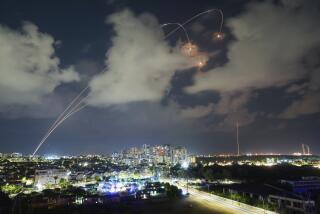More Tests of Missile Defense
- Share via
After six straight failures in its tests of a prototype battlefield missile defense system, the Army in recent months has chalked up two consecutive successes, and is so pleased that it canceled additional testing and said it would move toward final development of the project. But a Defense Department official questions the Army’s haste. Philip E. Coyle III, the Pentagon’s director of operational test and evaluation, says the successful tests at New Mexico’s White Sands Missile Range did not take place under realistic conditions. They were instead “shaped and scripted” in a way that helped give good results.
The system the Army is trying to develop is called THAAD, for Theater High Altitude Area Defense. Using advanced radar, mobile launchers and interceptor missiles, THAAD seeks to defend against incoming tactical missiles. To be effective, its interceptors must strike the enemy missile high above the ground. The projected cost of THAAD, which could be operational by 2007, is $15.4 billion.
Successful development of all modern weapons systems requires overcoming great technological challenges. Coyle isn’t saying that THAAD can’t work, or alleging that the most recent tests involved cheating. But he is urging further tests that would more closely replicate actual battlefield conditions before a final system is authorized. There are a lot of dollars and, more important, potentially a lot of American lives at stake. Congress should make Coyle’s concerns its own, and insist that THAAD testing continue, under the most realistic possible conditions.
More to Read
Sign up for Essential California
The most important California stories and recommendations in your inbox every morning.
You may occasionally receive promotional content from the Los Angeles Times.













